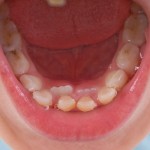
Caries remains one of the commonest disease of children with hundreds of millions of children worldwide requiring treatment. The proximal surfaces of primary molars are commonly affected and while amalgam restoration have good longevity their use is declining in favour of composite resin (CR) and glass ionomer cement (GIC).
The main aim of this review was to evaluate the clinical performance of GIC and CR in Class II restorations in primary molars. The study also evaluated the influence of type of GIC and isolation (rubber dam or cotton roll) on the clinical performance of restorations.
Methods
Searches were conducted in the PubMeb, Scopus, Web of Science, Virtual Health Library (VHL), OpenGrey, Clinical Trials Cochrane Library, ClinicalTrials.gov and OpenGrey databases. Randomised controlled clinical trials comparing the clinical performance of Class II restorations performed with composite resin (CR) and conventional or resin-modified glass ionomer cement (C-GIC or RM-GIC, respectively) in primary teeth were considered. Two reviewers independently selected studies and abstracted data and assessed risk of bias using the Cochrane tool.
Data on the restorations were dichotomised as “acceptable” (restorations without need of replacement or repair) or “unacceptable” (restorations presenting failures or requiring repair or replacement) and a number of meta-analyses were conducted.
Results
- 10 studies were included with 9 contributing to the quantitative analysis.
- 6 studies used a split-mouth design, 4 a parallel design
- 7 studies Used USPHS criteria, 2 applied the FDI criteria with 1 using their own criteria.
- 7 studies reported that restorations were performed using rubber dam isolation with 3 reported using cotton roll isolation.
- 6 studies were considered to be at low risk of bias and 4 unclear risk of bias.
- GIC and CR presented similar failure patterns; Risk difference [RD] = -0.04 (95%CI; -0.11 to 0.03) p = 0.25, I2 = 51%),
- Exclusion of studies with follow-up period <24 months or grouping according to the type of GIC (conventional or resin-modified), or according to the type of isolation (cotton roll or rubber dam), or according to the evaluation criteria applied did not affect the pattern of the results obtained.
- GIC exhibited significantly lower values of secondary carious lesions than CR; RD = 0.06 (95%CI; 0.0 to 0.10), p = 0.008, I2 = 0%).
- The materials presented similar performance regarding the overall effect, as well as for marginal discoloration, marginal adaptation and anatomical form.
- The superiority of GIC was maintained when resin-modified GIC and rubber dam isolation were analysed separately.
Conclusions
The authors concluded: –
the materials analysed (GIC and CR) presented similar clinical performance to each other concerning the percentage of failures, marginal adaptation, marginal dis- coloration and anatomical form in Class II restorations in primary teeth, regardless of the type of GIC or isolation. However, regarding the occurrence of secondary carious lesions, GIC presented superior clinical performance, and this effect was more evident for the resin-modified GIC used with rubber dam isolation. Therefore, the possibility of light curing, combined with its cariostatic properties, indicate that resin-modified GIC is a suitable material for Class II restorations in primary teeth. The high number of subgroups and the low number of studies included, however, are important limitations of the present review, emphasizing the need for well-controlled clinical trials addressing relevant variables related to the longevity of restorations in the primary dentition.
Comments
The reviews have conducted and extensive database search and only included RCTs. While 6 of the 10 included studies were considered to be at low risk of bias it should be noted that the reviewers decided to exclude the two domains of the Cochrane tool evaluating blinding (operators, participants and examiners).
This review is restricted to RCTS and compares just two material types for primary molar restoration. Earlier this year we considered a review by Chisini et al (Dental Elf – 15th Jan 2018) which compared longevity of primary molar restoration albeit including a broader range of study designs. The Chisini review highlighted that stainless-steel crowns had the best performance which was also the conclusion of the 2015 Cochrane review (Dental Elf – 6th Jan 2016).
Links
Primary Paper
Dias AGA, Magno MB, Delbem ACB, Cunha RF, Maia LC, Pessan JP. Clinical performance of glass ionomer cement and composite resin in Class II restorations in primary teeth: A systematic review and meta-analysis. J Dent. 2018 Apr 9. pii:S0300-5712(18)30073-3. doi:10.1016/j.jdent.2018.04.004. [Epub ahead of print] Review. PubMed PMID: 29649506.
Original Review protocol on PROSPERO
Other references
Dental Elf – 15th Jan 2018
Dental Elf – 6th Jan 2016
Crowns more effective than fillings for decay in primary molar teeth
Dental Elf – 25th Apr 2018
Primary molars: Hall technique most effective caries management option

[…] post Glass ionomer cement or composite resin for class II restoration in primary molars appeared first on National Elf […]